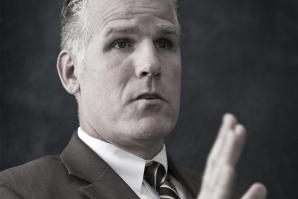Paul Navazio stepped into his role as Woodland city manager at a busy time for Yolo County. Since being appointed to the post in April 2012, Navazio has dived into the city budget, overseen the start of Woodland’s general plan update and continued to press ahead on an ambitious water project with the city of Davis, all with an eye on bringing more stable and high-paying jobs to the region. “It’s been the quickest 14 months I think I’ve had,” Navazio told Comstock’s recently. The 51-year-old city official spoke with us about the biggest issues facing Woodland in the year to come.
Comstock’s: You’re just a few months into your second
year here as city manager. Give us a recap of the highs and lows
of year one, and tell us what goals lie ahead.
Navazio: I’ve been spending a fair amount of time
working on trying to A) get a handle on and B) move the city
forward in terms of improving our financial situation and our
prospects. We have a lot of work to be done there, but I think
we’ve put some initial things in place that put us in a good
position. There are also some challenges we recognize that we
need to overcome. We are really focusing again on the fiscal —
economic development, jobs and the revitalization of downtown.
We’re also taking stock of the needs that we have within our
infrastructure as it relates to water, wastewater, streets and
roads. We’re seeing that as not only a quality-of-life need but
also critical to supporting economic development efforts.
Comstock’s: Woodland’s unemployment rate remains
higher than Yolo County’s as a whole. Where are the biggest
opportunities for bringing jobs to the community?
Navazio: Given our location and our ties to the
agricultural community, past efforts have really been focused on
some of the food, warehousing and transportation (industries),
which is still a strong component of our local economy. We’re
working locally and regionally with other communities to not only
take advantage of our existing and historical strengths, but to
move that whole model into the 21st century, if you will —
higher-tech, higher-paid work. We’re putting efforts in place to
position Woodland to be able to retain and attract some of the
opportunities that are out there, not just for Woodland, but for
our region.
Comstock’s: What do those efforts look like? Are
there specific initiatives or strategies for bringing those types
of jobs to Woodland?
Navazio: We are in the process of updating our general
plan, which is, in some way, going to lay the foundation for all
of our future development and growth priorities. A strong
emphasis is being placed on the economic element. We’re really
looking at how current policies that arose from past economic
development strategies need to be revisited or need to be left
alone or need to be tweaked. I can’t pretend that we have all the
answers yet, but we recognize the need to be a little more
business friendly and more receptive to working with businesses,
not only to serve our needs but also to serve their needs going
forward. One of the big issues that we have facing Woodland,
specifically to maximize our economic development potential, is
unfortunately the ongoing need to address flood issues. The city
has been working on that for a number of years, and these
projects take a lot of time, energy and focus. But we are
endeavoring as best we can to advance both local and regional
flood control projects, not only for the sake of flood control
and the protection of property as it currently exists, but also
as a key component of opening up opportunities on economic
development.
Comstock’s: What’s the status of that general plan
rewrite?
Navazio: We began the process about six months ago and
had a pretty ambitious plan to maybe complete it within 18
months, so our target date has been to complete it by June of
2014. We’ll have to see whether or not we can actually meet that.
To date, we’ve done a lot in the way of background analysis and
public outreach. We can potentially wrap it up by June 2014, but
I think there’s also an interest in making sure we have a good,
transparent, public engagement process to go along with it.
Comstock’s: Water continues to be a challenge for
Woodland, which I know asked residents to voluntarily reduce
water use this summer amid concerns about supply and quality.
What’s the status of the Woodland-Davis Clean Water Agency
project and other water initiatives currently under
way?
Navazio: We’re partnering effectively on the project,
which is going to transition both communities from our existing
groundwater supply system to a conjunctive use, which is a
combination of surface water from the Sacramento River and
groundwater. The short and long of it is, while it’s been a long
road and we’ve dealt with a number of issues to date, we’ve
successfully crossed off several milestones recently. We’re
hoping through our (joint powers authority agreement) to be under
contract for the design, construction and actual operation of the
surface water project sometime this fall with a target completion
date of 2016. The surface water project continues to be the most
expansive project both in terms of capital costs and scope we’ve
undertaken as a community. One of the challenges that we have is
to make sure that we get from here to 2016 in terms of being able
to sustain water quality.
Comstock’s: Whether it’s the water agreement or other
regional issues or partnerships, how has your background as a
former assistant city manager in Davis and your relationships and
experience there impacted progress on these issues?
Navazio: I would start by saying that, by and large, I
think there’s a general sense that, in comparison to other areas
even within the region, Yolo County has a pretty long history of
partnership and collaboration amongst local government, county
government and other interests. In that sense, it’s almost in our
DNA. What’s really helped me coming here with that background has
more to do with the familiarity with the agencies and the players
and this (water) project in particular. We didn’t really have a
huge learning curve on it. If nothing else, having a little bit
of perspective on how both communities view the project and the
interests that they have in the project has been helpful in
ensuring that we’re keeping the benefits of collaborations at the
forefront.
Recommended For You

Waterborne Disorder
In the event of flood, area hospitals are at risk
In the hours before Hurricane Sandy hit New York last year, the country’s oldest public hospital thought it was ready.

Realign. Redevelop.
Counties director Matt Cate thinks California is righting its course
No one can accuse Matt Cate of avoiding the hard jobs. During his four years at the helm of California’s state prisons, he guided the system through some of its toughest times, including historic budget cuts and the implementation of Gov. Jerry Brown’s controversial 2011 realignment plan, which shifted tens of thousands of offenders to local jails and parole supervision.


